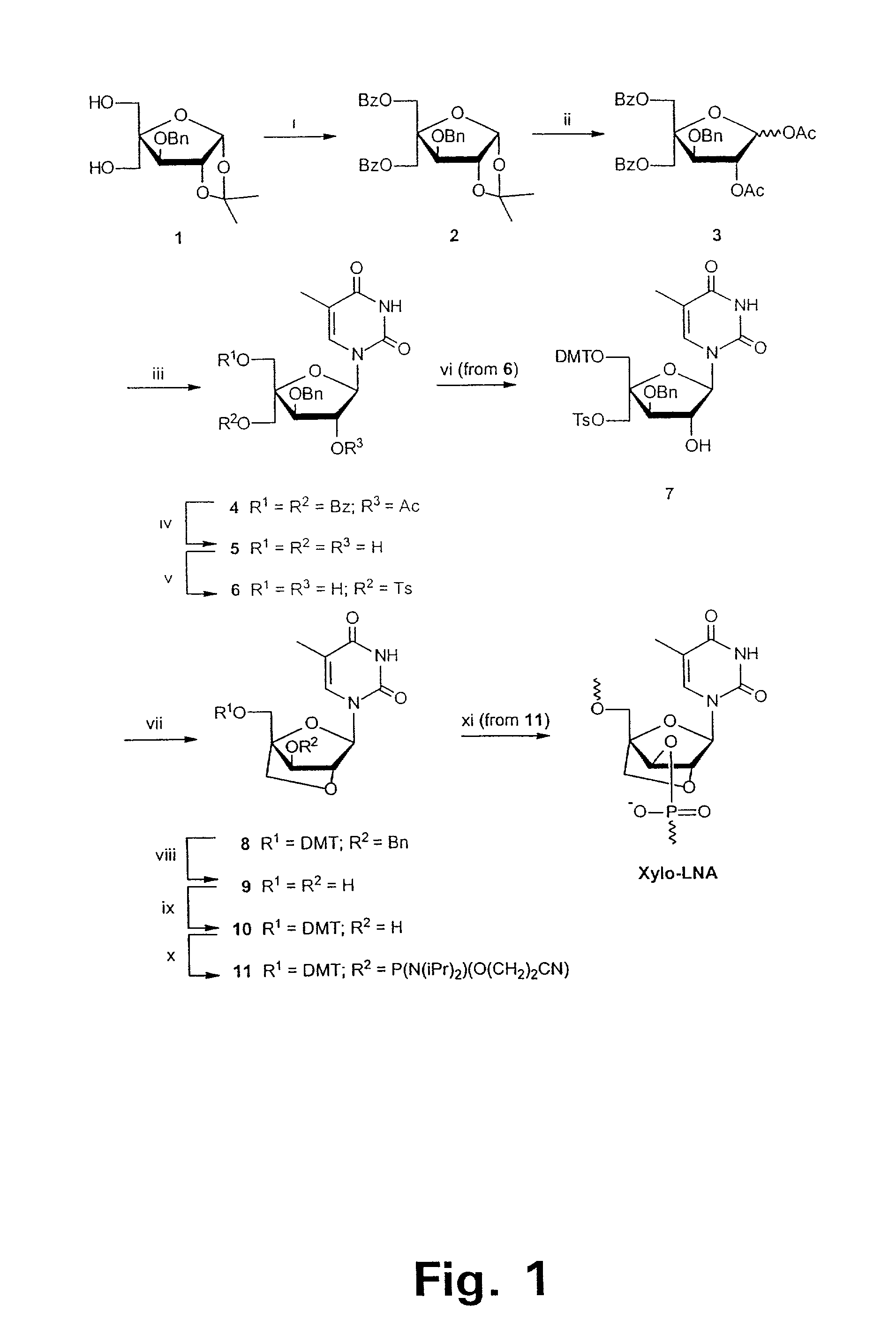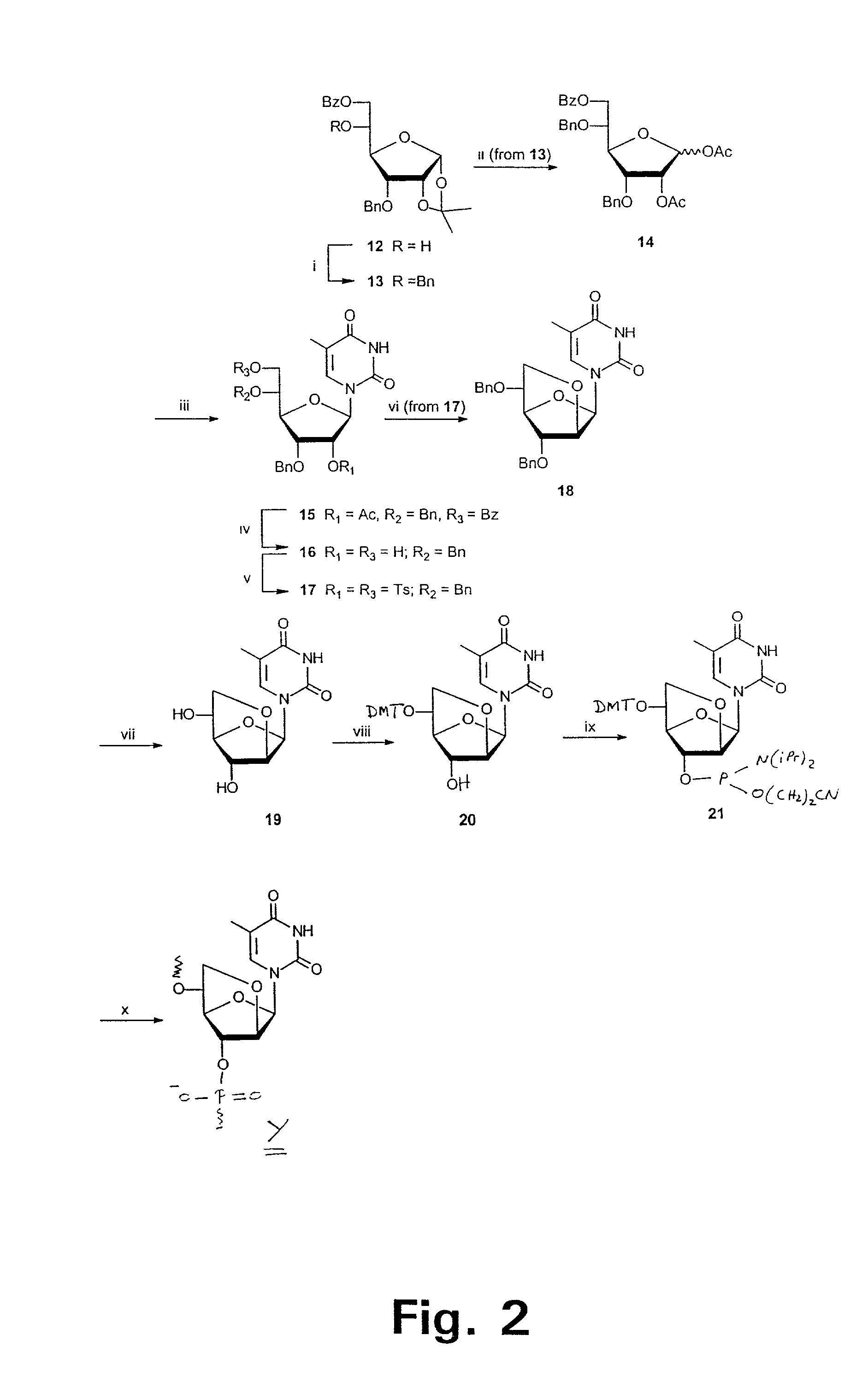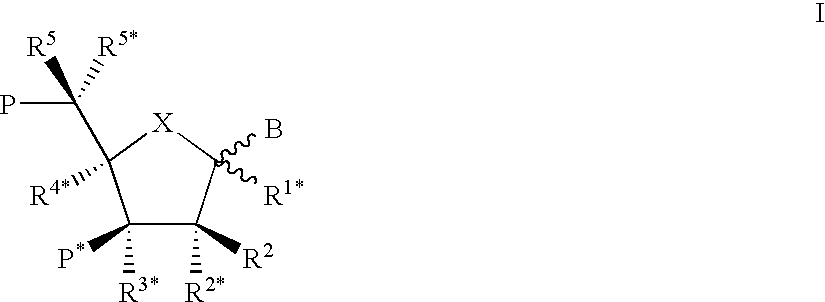Xylo-LNA analogues
a technology of xylo-lna and analogues, applied in the field of xylo-lna analogues, can solve the problems of less stable duplexes with complementary nucleic acids, complex appraisal of most of the reported analogues, and the formation of oligonucleotides containing these analogues
- Summary
- Abstract
- Description
- Claims
- Application Information
AI Technical Summary
Benefits of technology
Problems solved by technology
Method used
Image
Examples
example 1
[0191]5-Benzoyl-4-C-benzoyloxymethyl-3-O-benzyl-1,2-O-isopropylidene-α-D-glucofuranose (2). To a stirred ice cold solution of 3-O-benzyl-4—C-hydroxymethyl-1,2-isopropylidene-α-D-glucofuranose (1)26 (25.0 g, 0.096 mol) in anhydrous pyridine (60 cm3) was added benzoyl chloride (4.1 cm3, 0.035 mol). After stirring at room temperature for 4 h, the reaction mixture was cooled to 0° C., H2O (50 cm3) was added, and the mixture was extracted with dichloromethane (100 cm3×3). The combined organic phase was washed with saturated aqueous solutions of sodium hydrogen carbonate (30 cm3×3) and brine (20 cm3×3), dried (Na2SO4) and evaporated to dryness under reduced pressure. The residue was purified by silica gel column chromatography using first petroleum ether / dichloromethane (1:1, v / v) and then dichloromethane / methanol (99:1, v / v) as eluent to give furanose 2 (7.50 g, 90%) as a yellowish oil after evaporation of the solvents under reduced pressure.
[0192]δH (CDCl3) 8.02–7.23 (15H, m), 6.08 (1H,...
example 2
[0193]5-O-Benzoyl-4-C-benzoyloxymethyl-3-O-benzyl-1,2-di-O-acetyl-D-glucofuranose (3). A solution of furanose 2 (7.40 g, 0.014 mol) in 80% acetic acid (60 cm3) was stirred 9 h at 90° C. The mixture was evaporated to dryness under reduced pressure and the residue was coevaporated with toluene (10 cm3×3) and dissolved in anhydrous pyridine (80 cm3). Acetic anhydride (5.5 cm3) was added and the solution was stirred for 46 h at room temperature. The mixture was evaporated to dryness under reduced pressure and the residue was coevaporated with toluene (10 cm3×3) and dissolved in dichloromethane (150 cm3). The solution was washed with saturated aqueous solutions of sodium hydrogen carbonate (30 cm3×3) and brine (30 cm3×3), dried (Na2SO4) and concentrated under reduced pressure. The residue was purified by silica gel column chromatography using first petroleum ether / dichloromethane (1:1, v / v) and then dichloromethane / methanol (99:1, v / v) as eluent to give the anomeric mixture 3 (α:β=3:1, 7...
example 3
[0195]1-(2-O-Acetyl-5-O-benzoyl-4-C-benzoyloxymethyl-3-O-benzyl-β-D-xylofuranosyl)thymine (4). To a stirred suspension of the anomeric mixture 3 (7.26 g, 0.013 mol) and thymine (3.25 g, 0.028 mol) in anhydrous acetonitrile (80 cm3) was added N,O-bis(trimethylsilyl)acetamide (19.1 cm3, 0.077 mol). The reaction mixture was stirred at 60° C. for 1 h and then cooled to 0° C. Trimethylsilyl triflate (4.1 cm3, 0.023 mol) was added drop-wise during 10 min and the mixture was subsequently heated for 22 h under reflux. After cooling to room temperature, a saturated aqueous solution of sodium hydrogen carbonate (30 cm3) was added and extraction was performed using dichloromethane (100 cm3×3). The combined organic phase was washed with saturated aqueous solutions of sodium hydrogen carbonate (30 cm3×3) and brine (50 cm3×3), dried (Na2SO4) and concentrated under reduced pressure. The residue was purified by silica gel column chromatography using dichloromethane / methanol (0.5–2.0% methanol, v / v)...
PUM
 Login to View More
Login to View More Abstract
Description
Claims
Application Information
 Login to View More
Login to View More - R&D
- Intellectual Property
- Life Sciences
- Materials
- Tech Scout
- Unparalleled Data Quality
- Higher Quality Content
- 60% Fewer Hallucinations
Browse by: Latest US Patents, China's latest patents, Technical Efficacy Thesaurus, Application Domain, Technology Topic, Popular Technical Reports.
© 2025 PatSnap. All rights reserved.Legal|Privacy policy|Modern Slavery Act Transparency Statement|Sitemap|About US| Contact US: help@patsnap.com



